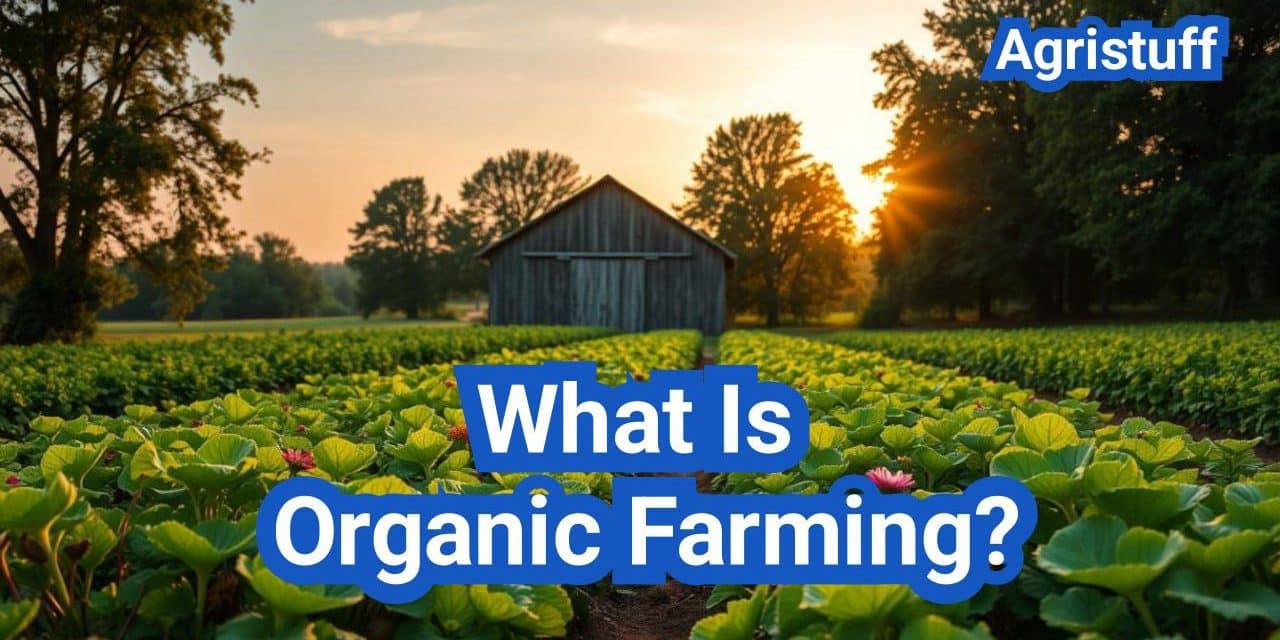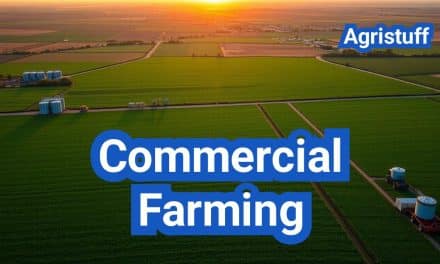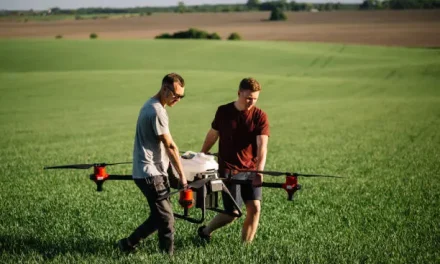Organic farming is a method of cultivating crops and raising livestock without the use of synthetic fertilizers, pesticides, or genetically modified organisms (GMOs).
This approach to agriculture focuses on maintaining soil health, promoting biodiversity, and using natural processes to control pests and diseases. By avoiding the use of chemicals, organic agriculture helps to protect the environment and preserve natural resources for future generations.
Sustainable farming practices like organic farming are gaining popularity as consumers become more aware of the importance of environmentally friendly food production methods.
Key Takeaways
- Organic farming avoids synthetic fertilizers, pesticides, and GMOs.
- It promotes soil health and biodiversity.
- Organic agriculture helps protect the environment.
- Sustainable farming practices are becoming increasingly popular.
- Organic farming preserves natural resources for future generations.
The Definition and Principles of Organic Farming
Organic farming stands out as a sustainable agricultural method that prioritizes environmental stewardship. This approach to farming is not just about producing food; it’s about creating a system that works in harmony with nature.
Core Philosophy Behind Organic Agriculture
The core philosophy of organic agriculture is rooted in the principles of health, ecology, care, and fairness. It’s about understanding the intricate relationships between farmers, consumers, and the land. Organic farming aims to maintain and enhance the health of the soil, plants, animals, and people.
Key Principles That Define Organic Practices
Organic practices are defined by several key principles, including the use of natural materials, avoidance of synthetic fertilizers and pesticides, and a focus on biodiversity. These principles guide farmers in making decisions that promote ecological balance and conserve biodiversity.
How Organic Farming Differs from Conventional Methods
Unlike conventional farming, which often relies on chemical inputs to boost yields, organic farming focuses on building healthy soil through natural amendments and crop rotation. This fundamental difference impacts not only the environment but also the quality of the produce.
| Aspect | Organic Farming | Conventional Farming |
|---|---|---|
| Soil Management | Uses natural amendments and compost | Relies on synthetic fertilizers |
| Pest Control | Employs crop rotation and biological controls | Uses chemical pesticides |
| Biodiversity | Promotes ecological balance | Often results in monoculture |
By understanding these differences, farmers and consumers can make informed choices about the food they produce and consume, supporting a more sustainable agricultural system.
The History and Evolution of Organic Farming

Organic farming has its roots in the early 20th century when visionaries like Sir Albert Howard and F.H. King began advocating for sustainable agricultural methods. Their work laid the foundation for what would become the modern organic movement.
Origins of Organic Agricultural Practices
The concepts of organic agriculture were developed as a response to the increasing industrialization of farming. Pioneers like Sir Albert Howard emphasized the importance of soil health and natural farming methods. As Howard once said, “The maintenance of the fertility of the soil is the fundamental problem of agriculture; on this, the whole future of the human race depends.”
“The maintenance of the fertility of the soil is the fundamental problem of agriculture; on this, the whole future of the human race depends.” – Sir Albert Howard
Development Throughout the 20th Century
The mid-20th century saw a significant shift with the publication of Rachel Carson’s Silent Spring, which highlighted the dangers of chemical pesticides and further galvanized the organic movement. This period was marked by growing awareness and adoption of organic practices.
Modern Organic Movement and Its Growth
In recent decades, the organic movement has experienced rapid growth, driven by consumer demand for healthier and more sustainable food options. Today, organic farming is recognized globally as a vital component of sustainable agriculture, contributing to biodiversity, soil health, and ecosystem services.
The evolution of organic farming continues, with ongoing research and innovation aimed at improving organic practices and increasing their adoption worldwide.
What Is Organic Farming? A Comprehensive Overview
As a holistic approach to agriculture, organic farming emphasizes the use of ecological processes to promote sustainable farming systems. This method of farming is characterized by its reliance on natural techniques for pest control and soil enrichment, differing substantially from conventional farming methods.
Defining Characteristics of Organic Production Systems
Organic production systems are distinguished by several key characteristics. These include the use of natural methods to control pests and diseases, avoidance of synthetic fertilizers and pesticides, and a focus on improving soil health through techniques like composting and crop rotation. Organic farming practices prioritize soil conservation and biodiversity, contributing to a more sustainable agricultural ecosystem.
The emphasis on natural methods means that organic farmers often employ techniques such as introducing beneficial insects to control pests or using physical barriers to prevent weed growth. These approaches not only reduce the environmental impact of farming but also help in maintaining the health of the soil and surrounding ecosystems.
The Holistic Approach to Agriculture
Organic farming is rooted in a holistic understanding of agriculture, viewing the farm as an integrated system that includes soil, plants, animals, and people. This approach recognizes the interconnectedness of different components within the farming system and seeks to promote ecological balance. The holistic approach encourages farmers to consider the long-term effects of their practices on the entire farm ecosystem.
“Organic farming is not just about avoiding the use of synthetic chemicals; it’s about creating a system that works with nature to produce healthy food while maintaining the health of the environment.”
Regulatory Definitions Across Different Regions
While the core principles of organic farming remain consistent, regulatory definitions can vary across different regions. In the United States, for example, the USDA sets strict standards for organic farming, including the prohibition of synthetic fertilizers and pesticides. Similarly, the European Union has its own set of regulations governing organic production. Understanding these regulatory definitions is crucial for farmers seeking organic certification and for consumers looking to purchase authentic organic products.
Farmers and consumers alike must be aware of the specific regulations in their region to ensure compliance and to make informed choices about the food they produce and consume.
Environmental Benefits of Organic Farming

Organic farming offers numerous environmental benefits that contribute to a more sustainable future. This approach to agriculture not only enhances the health of our ecosystems but also plays a crucial role in preserving natural resources for future generations.
Soil Health and Conservation
One of the primary environmental benefits of organic farming is its positive impact on soil health. By avoiding the use of synthetic fertilizers and pesticides, organic farming practices help maintain soil integrity, improve its structure, and increase its fertility. This, in turn, enhances water retention and reduces erosion.
Biodiversity Preservation
Organic farming promotes biodiversity by creating a more diverse and resilient ecosystem. Without the use of chemical pesticides, a variety of beneficial insects, birds, and other wildlife can thrive. As a quote from a renowned environmentalist states, “The way we farm is directly linked to the health of our ecosystems.”
“The health of our soil, water, and biodiversity is a direct reflection of our farming practices.”
Reduced Chemical Pollution
By eschewing synthetic chemicals, organic farming significantly reduces the amount of chemical pollution in our environment. This not only protects water sources but also contributes to cleaner air and healthier ecosystems.
Climate Change Mitigation Potential
Organic farming has a considerable potential for climate change mitigation. Practices such as crop rotation, cover cropping, and the use of organic amendments help sequester carbon in soils, reducing the overall carbon footprint of agricultural activities.
How to Assess Your Land for Organic Conversion
Before transitioning to organic farming, it’s crucial to evaluate your land’s potential. Assessing your land involves a comprehensive evaluation of its soil quality, water resources, and existing biodiversity.
Evaluating Soil Quality and History
Soil is the foundation of organic farming. Testing your soil will reveal its nutrient content, structure, and potential contaminants. A step-by-step soil testing guide can help you understand your soil’s needs.
Step-by-Step Soil Testing Guide
- Collect soil samples from different areas of your land.
- Send samples to a certified laboratory for analysis.
- Review the report to understand your soil’s nutrient levels and pH.
Water Resources Assessment
Adequate water supply is critical for organic farming. Evaluate your water sources, including wells, rivers, and rainfall patterns. Consider implementing water conservation techniques to optimize your water use.
Identifying Existing Biodiversity
Biodiversity is a key indicator of a healthy ecosystem. Observe the types of plants, insects, and animals on your land. This assessment will help you understand how to preserve and enhance biodiversity.
Creating Your Land Assessment Checklist
Developing a comprehensive checklist ensures you don’t miss critical aspects of your land assessment. Include factors like soil quality, water availability, and biodiversity.
| Assessment Factor | Indicators | Action Required |
|---|---|---|
| Soil Quality | Soil pH, Nutrient Levels | Soil Testing, Amendments |
| Water Resources | Availability, Quality | Conservation Techniques |
| Biodiversity | Plant and Animal Species | Habitat Preservation |
As noted by organic farming expert, Robert Rodale, “The health of our soil, our plants, and our people are all interconnected.” This holistic approach is fundamental to successful organic conversion.
“The earth is what we all have in common.” – Wendell Berry
Creating Your Organic Farm Plan: Step-by-Step Guide

An organic farm plan serves as a roadmap for farmers, guiding them through the transition process and beyond. It involves setting clear goals, designing the farm layout, and planning the transition period.
Setting Clear Goals and Timelines
Setting clear goals is the foundation of a successful organic farm plan. This involves defining what you want to achieve, whether it’s increasing biodiversity, improving soil health, or boosting crop yields. Establishing specific, measurable, achievable, relevant, and time-bound (SMART) objectives will help you stay focused.
- Define your short-term and long-term goals
- Identify key performance indicators (KPIs) to measure progress
- Establish a realistic timeline for achieving your goals
Designing Your Farm Layout
A well-designed farm layout is crucial for efficient operations and maximizing productivity. Consider factors such as crop rotation, irrigation systems, and access paths.
Planning the Transition Period
The transition period is a critical phase in organic farming. It requires careful planning to ensure a smooth shift from conventional to organic practices.
Sample Three-Year Transition Timeline
- Year 1: Conduct soil testing, develop a crop rotation plan, and start transitioning a portion of your land.
- Year 2: Expand organic practices to more areas of the farm, implement new irrigation systems, and start composting.
- Year 3: Complete the transition, achieve organic certification, and refine your farm plan based on lessons learned.
Resource Allocation Planning
Effective resource allocation is vital for the success of your organic farm. This includes planning for labor, equipment, and financial resources.
- Assess your current resources and identify gaps
- Develop a budget that accounts for organic certification costs, equipment upgrades, and labor expenses
- Explore potential funding opportunities or grants for organic farmers
By following these steps and creating a comprehensive organic farm plan, you can ensure a successful transition to organic farming practices and achieve your farming goals.
Building Healthy Soil: The Foundation of Organic Farming

The foundation of a thriving organic farm lies in its soil health, which is nurtured through careful management practices. Healthy soil is teeming with life, from microorganisms that help break down organic matter to insects that aerate the soil. This biodiversity is crucial for a resilient and productive farm.
How to Create Effective Compost Systems
Composting is a cornerstone of organic farming, turning waste into a valuable resource. To create an effective compost system, start by balancing “green” materials (like kitchen scraps and manure) with “brown” materials (such as straw and dried leaves). The ideal carbon-to-nitrogen ratio is crucial for efficient decomposition.
Key Components of Effective Composting:
- Balancing green and brown materials
- Maintaining adequate moisture
- Ensuring sufficient aeration
Implementing Cover Cropping Strategies
Cover cropping is another vital practice for enhancing soil health. By planting crops like legumes or rye, farmers can improve soil structure, increase biodiversity, and reduce erosion. The choice of cover crop depends on the specific needs of the soil and the farm’s overall rotation plan.
Benefits of Cover Cropping:
- Soil erosion control
- Nutrient cycling
- Habitat creation for beneficial insects
Applying Natural Amendments Correctly
Natural amendments, such as compost tea or fish bone meal, can provide essential nutrients to crops. It’s crucial to apply these amendments based on soil test results to avoid over-fertilization.
Compost Recipe for Different Farm Sizes
| Farm Size | Compost Ingredients | Quantity |
|---|---|---|
| Small | Green materials | 1 ton |
| Small | Brown materials | 2 tons |
| Medium | Green materials | 5 tons |
| Medium | Brown materials | 10 tons |
Seasonal Soil Management Calendar
| Season | Soil Management Activity |
|---|---|
| Spring | Apply compost, start cover cropping |
| Summer | Monitor soil moisture, control weeds |
| Fall | Incorporate cover crops into soil |
| Winter | Plan for next season’s amendments |
Natural Pest and Disease Management Techniques
The key to thriving organic crops lies in understanding and implementing natural pest and disease management techniques. Organic farming relies on a holistic approach to manage pests and diseases, focusing on preventive strategies and the use of beneficial organisms.
Implementing Preventive Strategies
Preventive measures are the first line of defense against pests and diseases. This includes:
- Crop rotation and diversification
- Using resistant crop varieties
- Maintaining healthy soil through proper nutrient management
- Ensuring good air circulation and water management
Attracting and Supporting Beneficial Insects
Beneficial insects, such as ladybugs and lacewings, are natural predators of common pests. To attract these beneficial insects, farmers can:
- Plant a diverse range of flowers that provide nectar and pollen
- Maintain ecological corridors and habitat diversity
- Avoid using broad-spectrum pesticides
Applying Organic-Approved Treatments
When preventive measures are not enough, organic farmers can use approved treatments. These include:
- Organic pesticides like neem oil and pyrethrin
- Biological controls such as introducing natural predators or parasites of the pest
Common Pest Identification Guide
Identifying pests correctly is crucial for effective management. Common pests include:
| Pest | Description | Damage |
|---|---|---|
| Aphids | Small, soft-bodied insects | Suck plant sap, causing curled or distorted leaves |
| Caterpillars | Larvae of butterflies and moths | Eat leaves, stems, and fruits |
Treatment Decision Flowchart
A systematic approach to deciding on treatments can be helpful. The following steps can guide the decision-making process:
- Identify the pest or disease
- Assess the severity of the infestation
- Choose the most appropriate organic treatment
- Monitor the effectiveness of the treatment
Planning Effective Crop Rotations and Selections

Effective crop rotation is crucial for maintaining soil health and maximizing yields in organic farming systems. By rotating crops, farmers can improve soil fertility, reduce pest and disease pressure, and enhance biodiversity.
Selecting Regionally Appropriate Crops
Choosing crops that are well-suited to the local climate and soil conditions is essential for successful organic farming. Regionally appropriate crops require fewer external inputs and are more resilient to local pests and diseases. For example, in areas with heavy rainfall, crops that thrive in wet conditions, such as rice or taro, can be excellent choices.
Designing Multi-Year Rotation Systems
A well-designed crop rotation plan involves rotating crops over several years to achieve a balanced ecosystem. This might involve rotating between legumes, cereals, and root vegetables to optimize soil nutrient use and structure. Multi-year rotation systems help in breaking disease and pest cycles, improving soil organic matter, and increasing crop diversity.
Implementing Companion Planting
Companion planting is a technique where different crops are grown together to improve growth, reduce pests and diseases, and enhance biodiversity. For instance, planting marigolds with tomatoes can help deter nematodes. This approach can be integrated into crop rotation plans to maximize benefits.
Sample Rotation Plans by Climate Zone
Different climate zones require tailored crop rotation plans. For example, in temperate zones, a rotation might include a sequence of small grains, followed by legumes, and then a root crop. In tropical regions, rotations might involve a mix of vegetables and grain crops that are resistant to local pests and diseases.
By carefully planning crop rotations and selections, organic farmers can create resilient and productive farming systems that benefit both the environment and their bottom line.
Chemical-Free Weed Management Strategies

Chemical-free weed management is a cornerstone of sustainable organic farming practices. Organic farming uses various methods to control weeds without relying on synthetic herbicides, focusing on maintaining soil health and biodiversity.
Preventive Cultural Practices
Preventive cultural practices are essential for effective weed management. These include:
- Using weed-free seeds and planting materials
- Implementing crop rotation plans to disrupt weed life cycles
- Maintaining optimal soil fertility to promote crop competitiveness
These practices help create an environment where crops can outcompete weeds.
Mechanical Control Methods and Tools
Mechanical control methods are another critical component of chemical-free weed management. Techniques include:
- Hand weeding for small areas or high-value crops
- Using mechanical tools like hoes, cultivators, and flame weeders
Effective Mulching Techniques
Mulching is a highly effective method for suppressing weeds by blocking light and preventing seed germination. Organic mulches like straw, wood chips, and grass clippings can be used.
Seasonal Weed Management Timeline
| Season | Weed Management Activities |
|---|---|
| Spring | Prepare soil, apply pre-emergent mulching, start mechanical weeding |
| Summer | Continue mechanical weeding, monitor for new weed growth |
| Fall | Clean up fields, apply post-harvest mulching |
| Winter | Plan for next season, maintain equipment |
By following this timeline, farmers can stay on top of weed management throughout the year.
Navigating the Organic Certification Process

Navigating the path to organic certification requires a thorough understanding of USDA organic requirements and meticulous record-keeping. This process, while complex, is a crucial step for farmers committed to organic practices.
Core Requirements for USDA Organic Certification
The USDA organic certification is based on a set of strict guidelines that ensure the integrity of organic farming practices. To comply, farmers must adhere to the following core requirements:
- Use of organic seeds and planting stock
- Prohibition on the use of synthetic fertilizers, pesticides, and genetically modified organisms (GMOs)
- Implementation of conservation practices to protect natural resources
- Maintenance of detailed records of farming practices and transactions
Preparing Comprehensive Documentation
Effective documentation is the backbone of a successful organic certification application. Farmers should prepare detailed records, including:
- Farm history and land use
- Crop rotation plans
- Soil testing results
- Pest and disease management practices
- Compost and manure management
Surviving the Inspection Process
The inspection process is a critical phase of organic certification. To ensure a smooth inspection, farmers should:
- Maintain organized and accessible records
- Be prepared to demonstrate compliance with USDA organic regulations
- Cooperate fully with the inspecting officer
Certification Checklist and Timeline
A well-structured checklist and timeline can significantly simplify the certification process. Here’s a basic outline:
| Task | Timeline |
|---|---|
| Review USDA organic requirements | Weeks 1-4 |
| Prepare documentation | Weeks 5-12 |
| Submit application | Week 13 |
| Inspection | Weeks 14-16 |
| Certification decision | Weeks 17-20 |
Common Certification Pitfalls to Avoid
Farmers should be aware of common pitfalls that can delay or jeopardize their certification, including:
- Incomplete or inaccurate documentation
- Failure to maintain detailed records
- Non-compliance with USDA organic regulations
Marketing and Selling Your Organic Products

Successfully marketing your organic products requires a multi-faceted approach that includes direct-to-consumer channels, wholesale markets, and a compelling brand story. As the organic sector continues to expand, farmers and producers must adapt their marketing strategies to effectively reach and engage their target audience.
Building Direct-to-Consumer Channels
Direct-to-consumer sales allow farmers to retain a larger share of the profit margin while building a loyal customer base. Strategies include:
- Developing a robust online presence through e-commerce platforms and social media
- Participating in local farmers’ markets and community-supported agriculture (CSA) programs
- Creating engaging in-store promotions and educational events
Accessing Wholesale Markets
Wholesale markets provide an opportunity to scale sales and reach a broader audience. To access these markets, consider:
- Building relationships with distributors and retailers who specialize in organic products
- Ensuring compliance with organic certification standards and other regulatory requirements
- Developing attractive packaging and branding that meets wholesale buyer expectations
Developing Your Organic Brand Story
A compelling brand story can differentiate your products in a crowded market. Key elements include:
- Highlighting your farm’s unique practices and values
- Sharing the story behind your products, such as the origin and production methods
- Emphasizing the environmental and social benefits of your organic farming practices
Pricing Strategy Guide
When setting prices for your organic products, consider factors such as production costs, market demand, and competitor pricing. A well-crafted pricing strategy can help you maintain profitability while remaining competitive.
Marketing Calendar Template
A marketing calendar can help you plan and organize your promotional activities throughout the year. Consider including seasonal promotions, product launches, and events that align with your brand and appeal to your target audience.
Overcoming Common Challenges in Organic Farming

As organic farming continues to grow in popularity, farmers are encountering various obstacles that must be overcome. Organic farming faces several challenges, including managing the transition period, addressing yield variability, and solving labor and time management issues.
Managing Transition Period Difficulties
The transition from conventional to organic farming can be challenging. It requires a significant change in farming practices, including the use of new techniques and the avoidance of synthetic fertilizers and pesticides. To manage this transition effectively, farmers should:
- Develop a detailed transition plan
- Seek guidance from experienced organic farmers
- Be prepared for potential yield reductions during the initial years
Addressing Yield Variability
Yield variability is a common issue in organic farming due to factors like weather conditions, soil health, and pest management. To address this, farmers can:
- Implement crop rotation and diversification strategies
- Use organic-approved treatments for pest and disease management
- Monitor soil health regularly
Solving Labor and Time Management Issues
Labor and time management are crucial in organic farming, where tasks like weeding and composting can be labor-intensive. Effective strategies include:
- Investing in appropriate machinery and tools
- Implementing efficient farm layouts
- Training farm workers in organic practices
Troubleshooting Guide for New Organic Farmers
New organic farmers often face unique challenges. A troubleshooting guide can help identify and solve common problems. Key areas to focus on include:
- Soil health monitoring
- Pest and disease management
- Record-keeping for continuous improvement
The Future of Organic Farming
Emerging trends and technologies are set to redefine the landscape of organic farming. As the sector continues to grow, it’s crucial to understand the factors that will shape its future.
Innovations in Organic Systems
The integration of emerging technologies such as precision agriculture, drones, and data analytics is enhancing the efficiency and productivity of organic farming. These technologies enable farmers to monitor crop health, optimize irrigation, and reduce waste.
Scaling Organic Practices
To achieve broader impact, organic practices need to be scaled up. This involves developing more efficient supply chains, enhancing farmer training programs, and promoting consumer education.
Policy Trends Affecting Organic Agriculture
Policy trends play a significant role in shaping the future of organic farming. Recent initiatives include increased funding for organic research, improved certification processes, and support for organic farming initiatives.
| Trend | Impact | Benefit |
|---|---|---|
| Emerging Technologies | Increased Efficiency | Improved Productivity |
| Scaling Organic Practices | Broader Adoption | Enhanced Sustainability |
| Policy Support | Favorable Regulations | Increased Growth |
Conclusion
As we have explored throughout this article, organic farming represents a significant shift towards more sustainable agricultural practices. By understanding the principles of organic farming, its history, and its environmental benefits, we can appreciate the importance of this approach in promoting ecological balance and reducing our environmental footprint.
The journey to adopting organic farming practices involves careful planning, from assessing your land and creating a farm plan to implementing natural pest management techniques and navigating the certification process. While challenges exist, the benefits of organic farming make it a worthwhile endeavor for farmers and consumers alike.
In summary, organic farming is not just a method of farming; it’s a commitment to sustainability and environmental stewardship. As we move forward, embracing organic practices can lead to healthier ecosystems, improved biodiversity, and a more sustainable food system. This conclusion highlights the value of organic farming as a crucial component of our agricultural future.
FAQ
What is organic farming?
Organic farming is a method of crop and livestock production that avoids the use of synthetic fertilizers, pesticides, and genetically modified organisms. It focuses on maintaining soil health, biodiversity, and ecological balance.
How does organic farming differ from conventional farming?
Organic farming differs from conventional farming in its avoidance of synthetic chemicals, emphasis on natural pest control, and focus on soil health through methods like composting and cover cropping.
What are the key principles of organic farming?
The key principles include maintaining soil health, conserving biodiversity, using natural pest control methods, and avoiding synthetic fertilizers and pesticides.
How do I assess my land for organic conversion?
Assessing land for organic conversion involves evaluating soil quality, water resources, and existing biodiversity. Soil testing and creating a land assessment checklist are crucial steps.
What is the importance of soil health in organic farming?
Soil health is crucial as it supports plant growth, aids in carbon sequestration, and helps in maintaining biodiversity. Practices like composting, cover cropping, and using natural amendments are essential for building healthy soil.
How do organic farmers manage pests and diseases?
Organic farmers use preventive strategies, attract beneficial insects, and apply organic-approved treatments to manage pests and diseases.
What is the role of crop rotation in organic farming?
Crop rotation is vital for maintaining soil fertility, reducing pest and disease pressure, and promoting biodiversity. It involves selecting regionally appropriate crops and designing multi-year rotation systems.
How do organic farmers control weeds?
Organic farmers use preventive cultural practices, mechanical control methods, and effective mulching techniques to manage weeds.
What is the process of obtaining organic certification?
Obtaining organic certification involves understanding USDA organic requirements, preparing documentation, and surviving the inspection process.
How can I market my organic products?
Marketing organic products involves building direct-to-consumer channels, accessing wholesale markets, and developing a brand story that highlights the organic and sustainable aspects of your products.
What are the common challenges faced by organic farmers?
Common challenges include managing the transition period, addressing yield variability, and solving labor and time management issues. Planning and preparation are key to overcoming these challenges.
What is the future of organic farming?
The future of organic farming is promising, with emerging technologies, scaling of organic practices, and supportive policy trends expected to drive growth and adoption.
How does organic farming contribute to environmental sustainability?
Organic farming contributes to environmental sustainability by promoting soil health, conserving biodiversity, reducing chemical pollution, and mitigating climate change.










